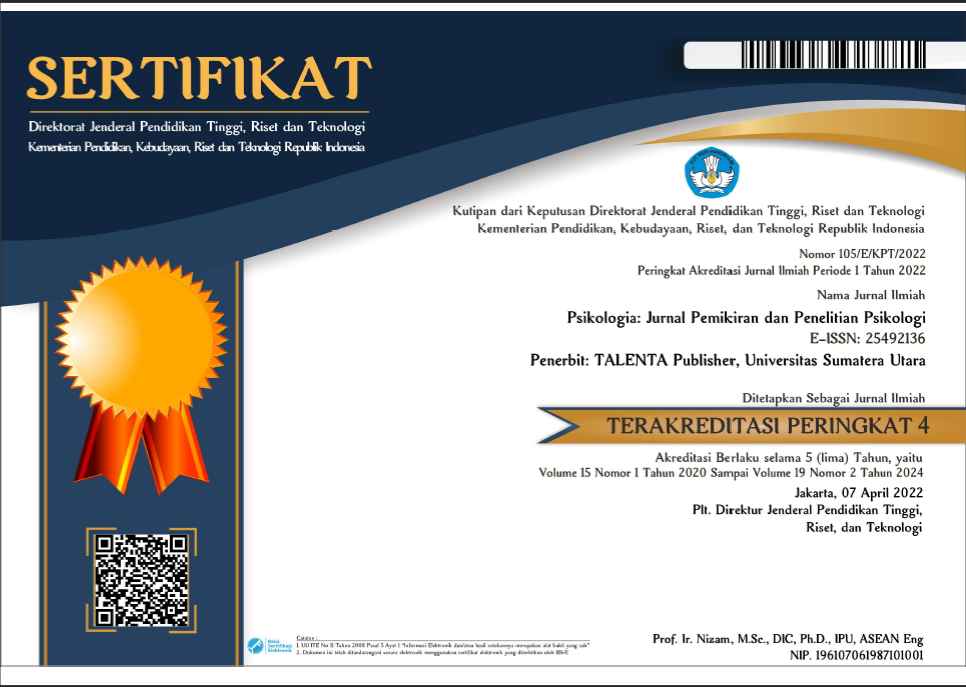Psychological distress of ghosting victims
Gambaran kesulitan psikologis korban ghosting
DOI:
https://doi.org/10.32734/psikologia.v16i2.7312Keywords:
psychological distress, ghosting, early adulthoodAbstract
This study examines the psychological distress of ghosting victims among early adults. Ghosting is a break-up strategy by suddenly disappearing that is popular among early adults because it is thought to cause several negative effects for the recipient. This study involved 160 early adults aged 18-25 years old who experienced ghosting in past one month by undergoing intense relationships through social media for at least 2 months. The result shows that early adults who were ghosted, experienced psychological distress on a moderate scale.
Penelitian ini mengkaji mengenai gambaran psychological distress korban ghosting pada usia dewasa awal. Ghosting merupakan suatu strategi pemutusan hubungan dengan menghilang secara tiba-tiba yang sedang populer di kalangan usia dewasa muda dan dianggap menyebabkan beberapa efek negatif bagi penerimanya. Penelitian ini melibatkan 160 orang dewasa awal usia 18-25 tahun yang pernah mengalami ghosting dalam satu bulan terakhir dengan menjalani hubungan intens melalui media sosial selama minimal 2 bulan. Hasilnya menunjukkan bahwa individu dewasa awal korban ghosting mengalami psychological distress pada skala sedang.
Downloads
References
Hurlock, E. B. (1997). Psikologi perkembangan: Suatu pendekatan sepanjang rentang kehidupan. Jakarta: Erlangga.
Koessler, R. B., Kohut, T., & Campbell, L. (2019). When Your Boo Becomes a Ghost: The Association Between Breakup Strategy and Breakup Role in Experiences of Relationship Dissolution. Collabra: Psychology, 5, 29. https://doi.org/10.1525/collabra.230
Koessler, R. B., Kohut, T., & Campbell, L. (2019). Integration and expansion of qualitative analyses of relationship dissolution through ghosting. PsyArXiv. https://doi.org/10.31234/osf.io/3kvdx
Kristof-Brown, A., Barrick, M. R., & Kay Stevens, C. (2005). When Opposites Attract: A Multi-Sample Demonstration of Complementary Person-Team Fit on Extraversion. Journal of Personality, 73, 935–958. https://doi.org/10.1111/j.1467-6494.2005.00334.x
LeFebvre, L. E., & Fan, X. (2020). Ghosted?: Navigating strategies for reducing uncertainty and implications surrounding ambiguous loss. Personal Relationships, 27, 433–459. https://doi.org/10.1111/pere.12322
McCroskey, J. C., & Richmond, V. P. (1979). The impact of communication apprehension on individuals in organizations. Communication Quarterly, 27, 55–61. https://doi.org/10.1080/01463377909369343
Ranzini, G., Hetsroni, A., & Tuncez, M. (2019). Crossing boundaries? Dating platforms and interracial romance.
Ridner, S. H. (2004). Psychological distress: Concept analysis. Journal of Advanced Nursing, 45, 536–545. https://doi.org/10.1046/j.1365-2648.2003.02938.x
Navarro, R., Larrañaga, E., Yubero, S., & VÃllora, B. (2020). Psychological correlates of ghosting and breadcrumbing experiences: A preliminary study among adults. International Journal of Environmental Research and Public Health, 17. http://doi.org/10.3390/ijerph17031116
Published
How to Cite
Issue
Section
License
Copyright (c) 2021 Psikologia: Jurnal Pemikiran dan Penelitian Psikologi

This work is licensed under a Creative Commons Attribution-ShareAlike 4.0 International License.








